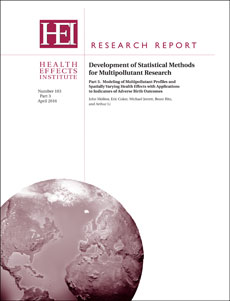You are here
Novel Statistical Methods for Studying Pollutant Mixtures
 HEI Research Report 183, Part 3, Modeling of Multipollutant Profiles and Spatially Varying Health Effects with Applications to Indicators of Adverse Birth Outcomes, describes a study to develop and apply statistical methods to analyze the effects of multipollutant exposures on health, expanding beyond the two-pollutant approaches used in many studies to date. HEI funded three innovative studies in recent years to improve the tools for analyzing complex multipollutant exposures. In the last report from these studies, John Molitor and colleagues describe a Bayesian framework to identify spatial clusters of air pollution exposures — and other covariates such as socioeconomic status — and estimated pregnancy outcomes associated with those clusters, using a data set for Los Angeles county. Read more about this report in the Spring 2016 Newsletter. See also Research Report 183, Parts 1 and 2 (by Brent Coull and Eun-Sug Park, respectively).
HEI Research Report 183, Part 3, Modeling of Multipollutant Profiles and Spatially Varying Health Effects with Applications to Indicators of Adverse Birth Outcomes, describes a study to develop and apply statistical methods to analyze the effects of multipollutant exposures on health, expanding beyond the two-pollutant approaches used in many studies to date. HEI funded three innovative studies in recent years to improve the tools for analyzing complex multipollutant exposures. In the last report from these studies, John Molitor and colleagues describe a Bayesian framework to identify spatial clusters of air pollution exposures — and other covariates such as socioeconomic status — and estimated pregnancy outcomes associated with those clusters, using a data set for Los Angeles county. Read more about this report in the Spring 2016 Newsletter. See also Research Report 183, Parts 1 and 2 (by Brent Coull and Eun-Sug Park, respectively).

